MARIANI’SVirtual Gourmet
December 11,
2011
NEWSLETTER
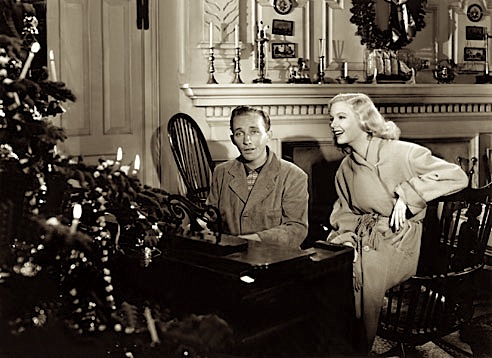
Bing
Crosby and Marjorie Reynolds sing "White
Christmas: in the movie "Holiday Inn" (1942)
❖❖❖
THIS WEEK
WHERE TO EAT IN L.A. RIGHT NOW
by John Mariani
NEW YORK CORNER: PORTER HOUSE
by John Mariani
SWEETS FOR THE SWEET IGNORE DESSERT WINE PAIRINGS
by John Mariani
❖❖❖
WHERE
TO EAT IN L.A. RIGHT NOW
by John Mariani
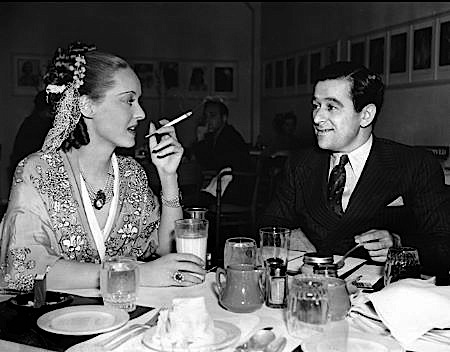
The
doldrums of dining out in L.A. have finally
ended after a decade when no one could come up
with the Next Big Thing. So instead chefs went
back to cooking well and Los Angelenos seem to
have sighed in relief, content to eat fine food
in casual spaces and to spot a few celebs now
and then. (The Michelin Guide ceased publication
of its L.A. guide after one year because, its
then-director sniffed, Los Angelenos don’t
really care about the food, only the sightings.)
The city is still heavy with
sushi and Mexican, but, as it has for the past
five years, Italian rules, especially after
the success of Nancy Silverton and Mario
Batali’s Mozza. French cuisine is on life
support, modernist cuisine has made no
headway, and Wolfgang Puck has opened yet
another restaurant, this time in the $100
million rehab of the Hotel Bel-Air, with the
name. . . .(drum roll). . . Wolfgang Puck at
Hotel Bel-Air. Here are some of new
places that have put L.A. right again.
Mr. C Restaurant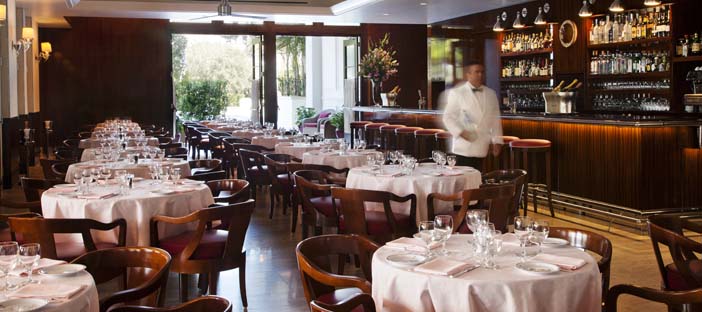
Mr. C Hotel
1224 Beverwill Drive
310-277-2800
www.mrchotels.com
If
you wander into Mr. C. Restaurant from the entry way
to the chic new Mr. C Hotel (the first in what the
Cipriani family hopes will be a worldwide deluxe
chain), you may do a Hollywood double take—doing!—when
you wonder if you’re on a set for a movie about
Harry’s Bar in Venice, maybe with Helena Bonham
Carter or Kate Blanchett.
Though larger than
the original, which opened in the 1930s and was
Hemingway’s favorite haunt in the 1950s, it looks
almost exactly the same, right down to the wall
clock, the polished mahogany bar, the tablesettings,
the low tables, the color of the linens, glassware,
waiters' jackets, and the menu. The crowd is
considerably more Tinseltown than Venice, but then
the original Harry's Bar was never without a few
show biz celebs.
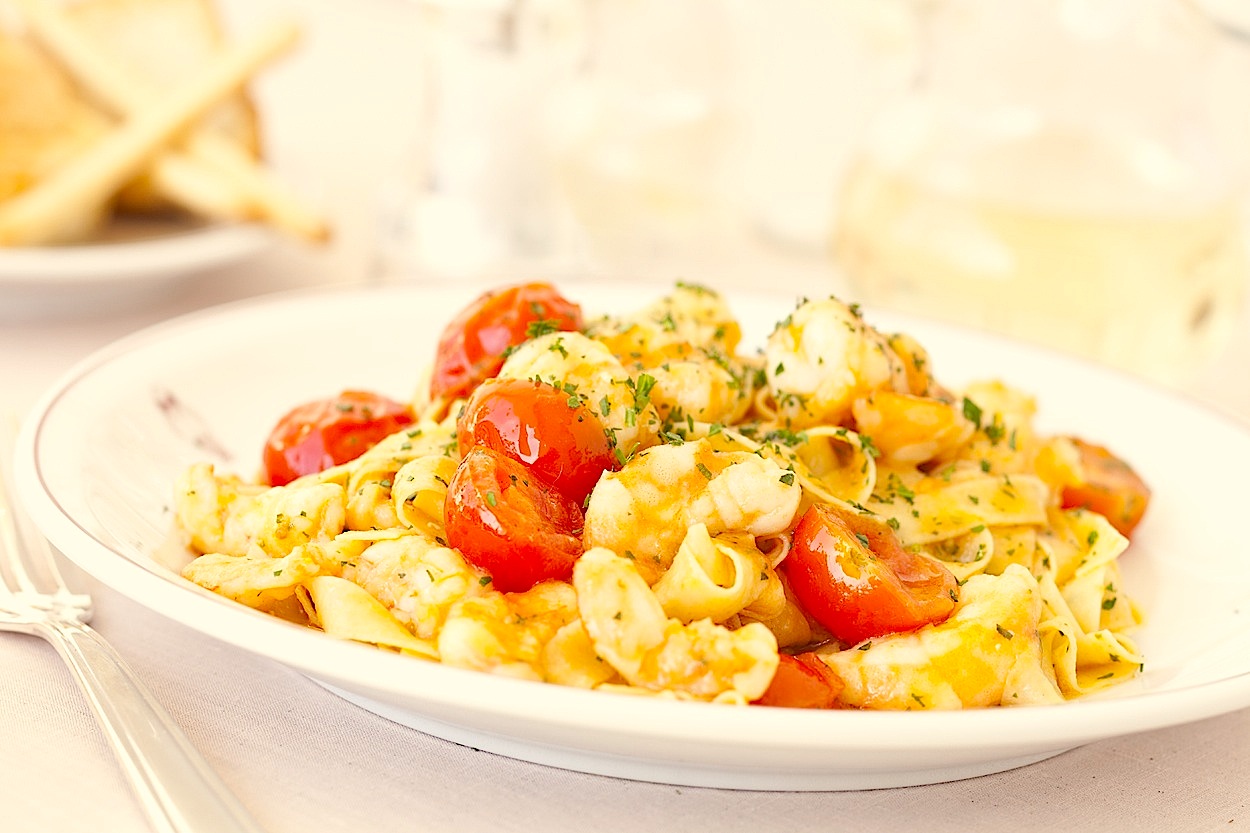 It’s really
quite a trick of trompe l’oeil, and when you begin
with a bellini and plate of carpaccio, you’ll know
this is no mere facsimile. Mr. C.’s food comes
pretty damn close to what you’ll get at Harry’s Bar
(a name the Ciprianis have never replicated, though
others, shamelessly have). The prices are actually a bit
less than in Venice.
It’s really
quite a trick of trompe l’oeil, and when you begin
with a bellini and plate of carpaccio, you’ll know
this is no mere facsimile. Mr. C.’s food comes
pretty damn close to what you’ll get at Harry’s Bar
(a name the Ciprianis have never replicated, though
others, shamelessly have). The prices are actually a bit
less than in Venice.
Here are the Cipriani classics: baked tagliolini
with ham; ; scampi al curry; pasticcio di
tagliardi verdi alla bolognese; and those
wonderful, silly meringue desserts. Prices are
a tad lower than in Venice, with full portions of
pasta around $26, easy enough to share with a
friend.
The
hotel itself has a bright newness about it, its
138 spacious rooms done up with big
black-and-white photos of Italian movie
stars. Downstairs there is a soigné
bar and lounge, outside of which is a crew of
parking attendants who, when I stayed there, were
much in need of direction. The fact that the
hotel is off the beaten track, on a curiously
named street--Beverwill--gives its rooms a welcome
quietude, and coming down to breakfast at that
splendid repro of Harry's Bar makes a stay here an
almost nostalgic moment. The
fact that it offers the luxury of L.A. hotels like
the Four Seasons and Hermitage at somewhat lower
rates means it's in tune with the times.
Playa
7360 Beverly Boulevard
323-933-5300
Esquire named John Sedlar “Chef of
the Year 2011” for a body of work that goes back to
the 1980s, when he introduced a refined style of
Cal-Mexican cuisine in L.A. He was
born in Santa Fe and always tried to marry Mexican
and South American food with a Southern California
swagger, first at Bikini in L.A. in 1991, then
Abiquiu in 1994—both representing the early-on cutting
edge of Neo-Latino cuisine. After the
devastating earthquake in the city, Sedlar left the
restaurant business to open a food company,
returning to the business two years ago with
high-style Rivera downtown, because, he says, “My
chef friends were having a lot more fun than I was.”
cutting
edge of Neo-Latino cuisine. After the
devastating earthquake in the city, Sedlar left the
restaurant business to open a food company,
returning to the business two years ago with
high-style Rivera downtown, because, he says, “My
chef friends were having a lot more fun than I was.”
Now, this year, he has opened the more casual
Playa, where he works around “reflexiones”—windows
into memories—thematic dishes that subtly reflect
his favorite chefs or movies (“A Clockwork Orange” [right] was a
theme this summer), all drawn from decades of visits
to Mexico, South America and Spain, which gave him
the taste and experience to write authoritative
books like Modern
Southwest Cuisine and to
host a video named Tamale Madness.
So, go to Playa with some friends and order a
mess of tortillas he calls “maize cakes,” one made
with wild mushrooms, black garlic, olives crushed to
look like soil, L’Explorateur cheese, and a
mushrooms foam; another is a wrap of burrata cheese
with salsa
verde, arugula, amaranth, and Sal de Colima
sea salt. Try
to assess the delicacy of a dish like his fresh corn
custard with Cotija cheese, black quinoa and squash
blossom sauce, and learn how he builds such
wonderful flavors into piquillos
relleños with Gruyère, golden
raisins, and chorizo. None of it will cost you very
much either.
PUBLIC KITCHEN AND BAR
Roosevelt
Hotel
7000 Hollywood Boulevard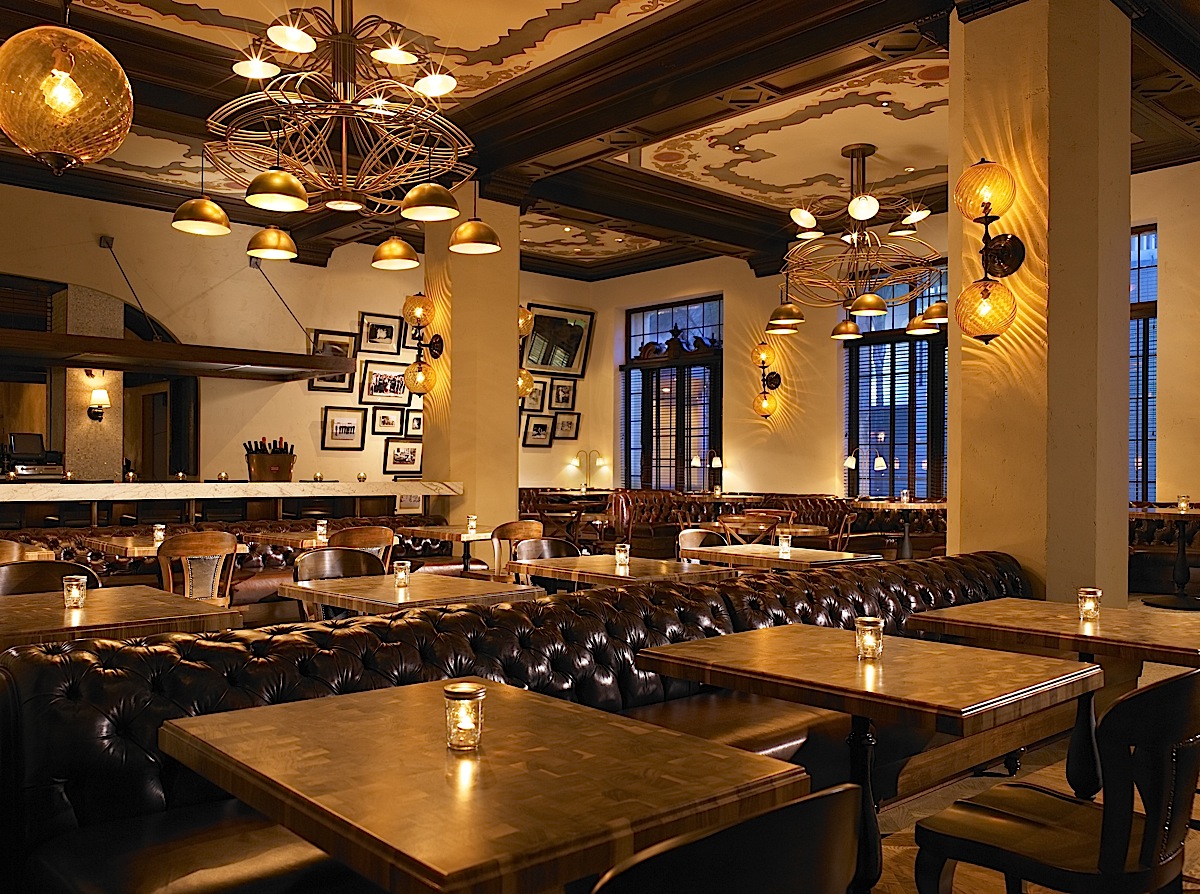
323- 933-5300
The
restoration of the historic Hollywood Roosevelt
Hotel demanded a great deal of tact and respect for
the place’s lineaments, and the owners did a bang-up
job, retaining the shadowy Old Hollywood
interiors—even adding a beautiful new bowling alley
upstairs that looks very old—and making Public
Kitchen & Bar into the kind of place those
entertainers who have stars and footprints across
the street at Grauman’s Chinese Theater would repair
for drinks and food after a movie opening.
Public K&C has some of the best-looking
staff in the city, and Chef Tim Goodell wants to
please everyone; portions are big, and the crowd
comes for a good time. The burger is as good as are
the steaks and chops and the pork schnitzel, but the
apps like squash blossom with three cheeses; chicken
liver terrine with fruit marmalade; and the
Neapolitan meatballs are going to hard to resist. The motto
here is “EVERYTHING TASTES BETTER WITH AN EGG ON
IT.”
block
tables, 1960's library chairs,
 Sotto
Sotto
9575 West Pico Boulevard
310-277-0210
“Sotto”
means “below” and you have to go down a few steps,
across from the 20th Century Fox lot, and
enter into a rustic trattoria whose
hostess—Nicole—may look familiar: she was a winner
on “America’s Top Model” a season or two ago. Congenial
G-M Gina Pepito is very easy on the eyes too.
The room is all
rough wood and old caged light bulbs, with wine
bottles hung from a ceiling rack, a communal table,
and open 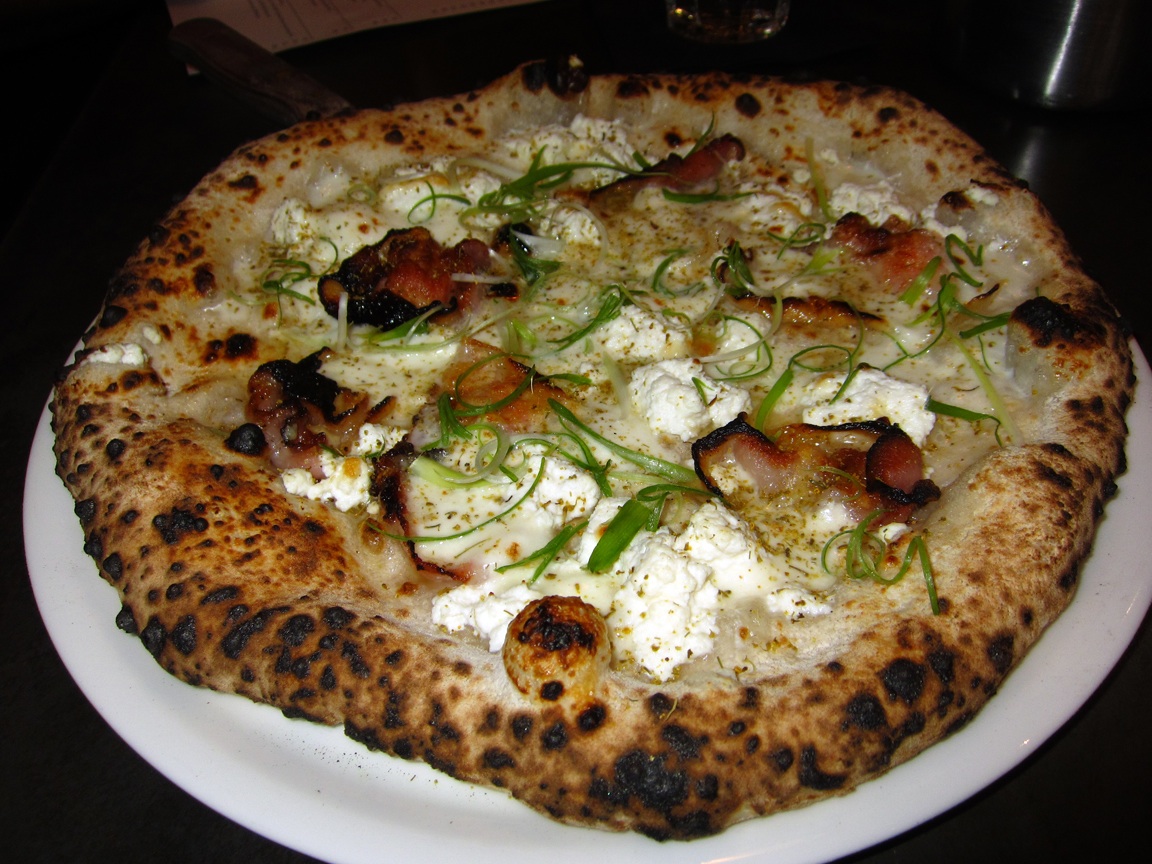 kitchen. Back there work
Steve Samson and Zach Pollack, the latter turning
out bubbling, char-crusted pizzas (right) that are
perhaps the best in Los Angeles right now, not least
a calzone called “Homage to Caiazzo” (a town in
Campania), packed with escarole, capers, Gaeta
olives, and creamy burrata.
kitchen. Back there work
Steve Samson and Zach Pollack, the latter turning
out bubbling, char-crusted pizzas (right) that are
perhaps the best in Los Angeles right now, not least
a calzone called “Homage to Caiazzo” (a town in
Campania), packed with escarole, capers, Gaeta
olives, and creamy burrata.
They're nice kids
doing what they love and it shows in every dish.
Their repertoire is culled from regions like Puglia,
Abruzzo, Campania, and Calabria, which becomes
obvious on the first bite of the roast griarelli peppers
with capers and oregano. Sicilian sardines with citrus
salsa and olive-pistachio vinaigrette tingles on the
tongue, and rich al dente
pastas like bucatini with tomato and Fiore Sardo
cheese and casarecce
with braised lamb ragù, egg and pecorino have
just the right bite. This is not a place to
bring an attitude.
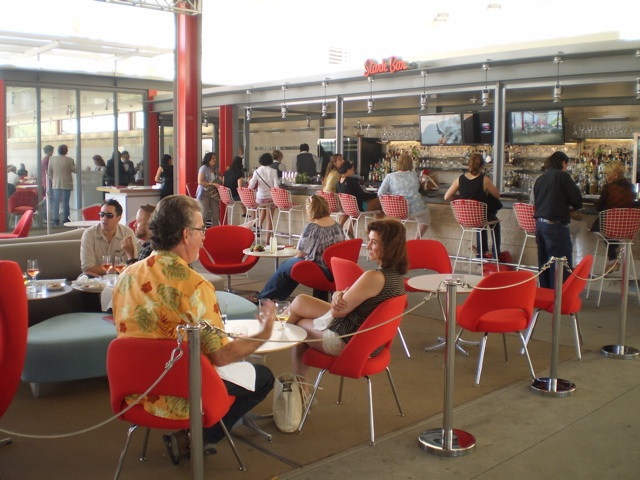 Ray’s
&
Stark Bar
Ray’s
&
Stark Bar
Los Angeles Museum of Contemporary Art,
5905 Wilshire Boulevard
323-857-6180
The
Patina Group that gave L.A. the elegant Patina
restaurant at the Walt Disney Music Center downtown
has now provided another great L.A. institution, the
Museum of Contemporary Art, with a more winsome but
no less delectable place to dine and, next to it, a
swank bar that is usually packed by six with an arts
and entertainment crowd—who book a lot of parties
here. The Ray Stark in question is the producer of
films like “Funny Girl” and “Steel Magnolias,” and
the restaurant is a gift of his foundation.
The
restaurant on the plaza is a glass rectangular box,
designed by Italian architect Renzo Piano, with the
feeling of a de Chirico painting bathed in Southern
California sunshine. Inside are lipstick red seats,
Eames chairs, and gleaming polished metal, and Ellen
Palevsky’s collection of more than 150 designer cups
from 1850-1950 in neat little white shelves.
Chef
Chris Morningstar, who worked at Patina, cooks with
an artistic flair that fits impeccably into the
Museum’s tenor, with wholly modern ideas like
wood-roasted chile, chorizo, dates and goat’s cheese
with almond sauce; yellowtail with an avocado cream,
smoked tomato jelly, and crispy potatoes; and a
coffee pudding with smoked caramel, espresso
granité, and a chocolate cigarette. It’s food
with a frisky panache, clean tastes in splashes of
color, as sensuously sunny as a David Hockney pool
painting.
NEW
YORK CORNER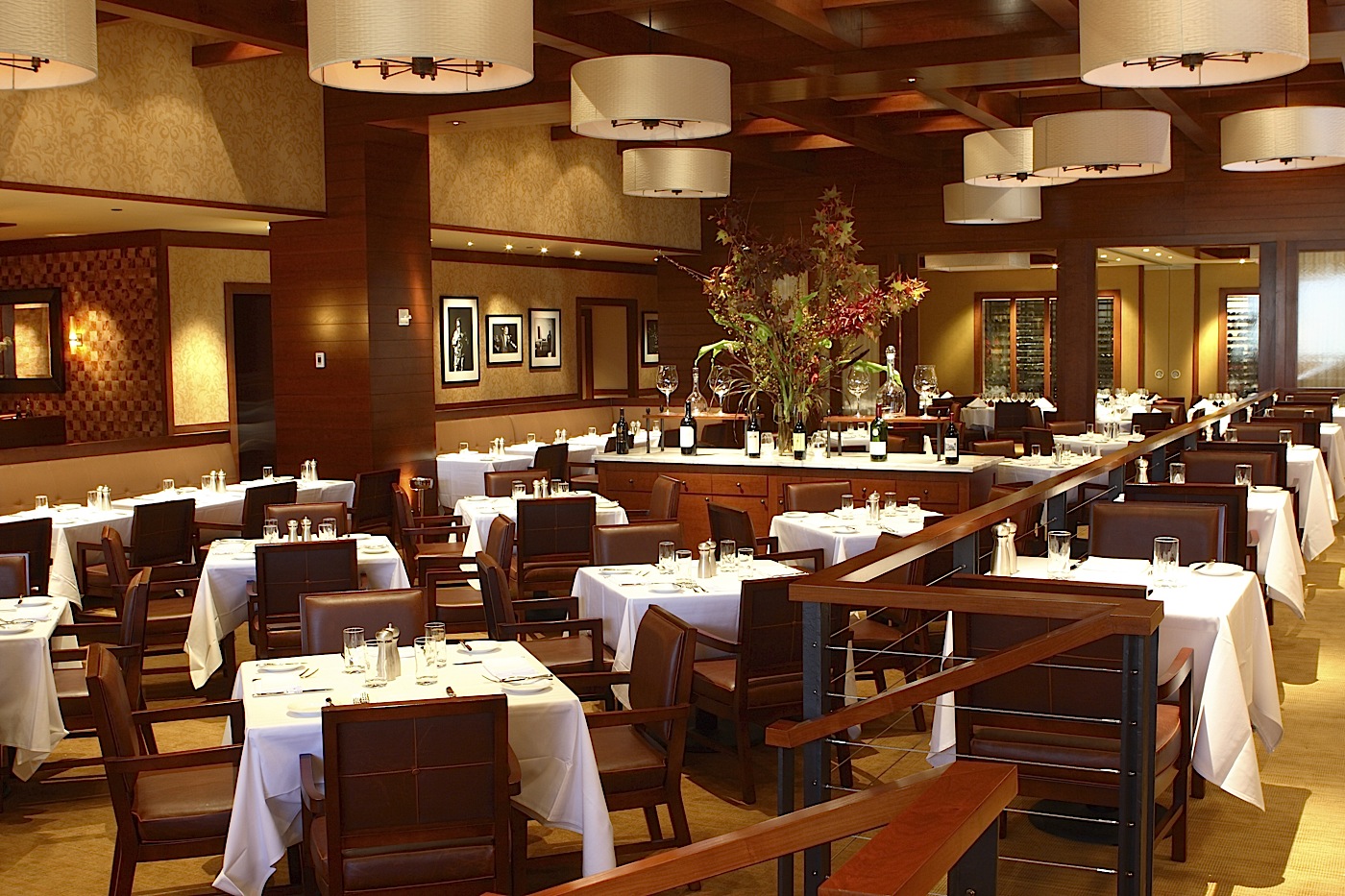
PORTER
HOUSE NEW YORK
10 Columbus Circle
212-823-9500
www.porterhousenewyork.com
Despite
naysayers who contended no New Yorker would ever go up
three or four flights of escalator to eat at a
restaurant, the resounding success of
Per Se, A Voce, Masa, Landmarc, and Porter House NY is
nothing short of a phenomenon after seven years.
Within its large dining room and bar area of 140
seats, Porter House rarely has an empty table any
evening of the year, recession re-schmession. There
are
big roomy, round booths, no tables crammed in, no
lousy tables for out-of-towners, no bad
lighting. Broad tables with soft tablecloths,
good stemware, and a view of Central Park that makes
you swoon, the Jeffrey Beers-designed room is a
testament to New York swank without being "swanky."
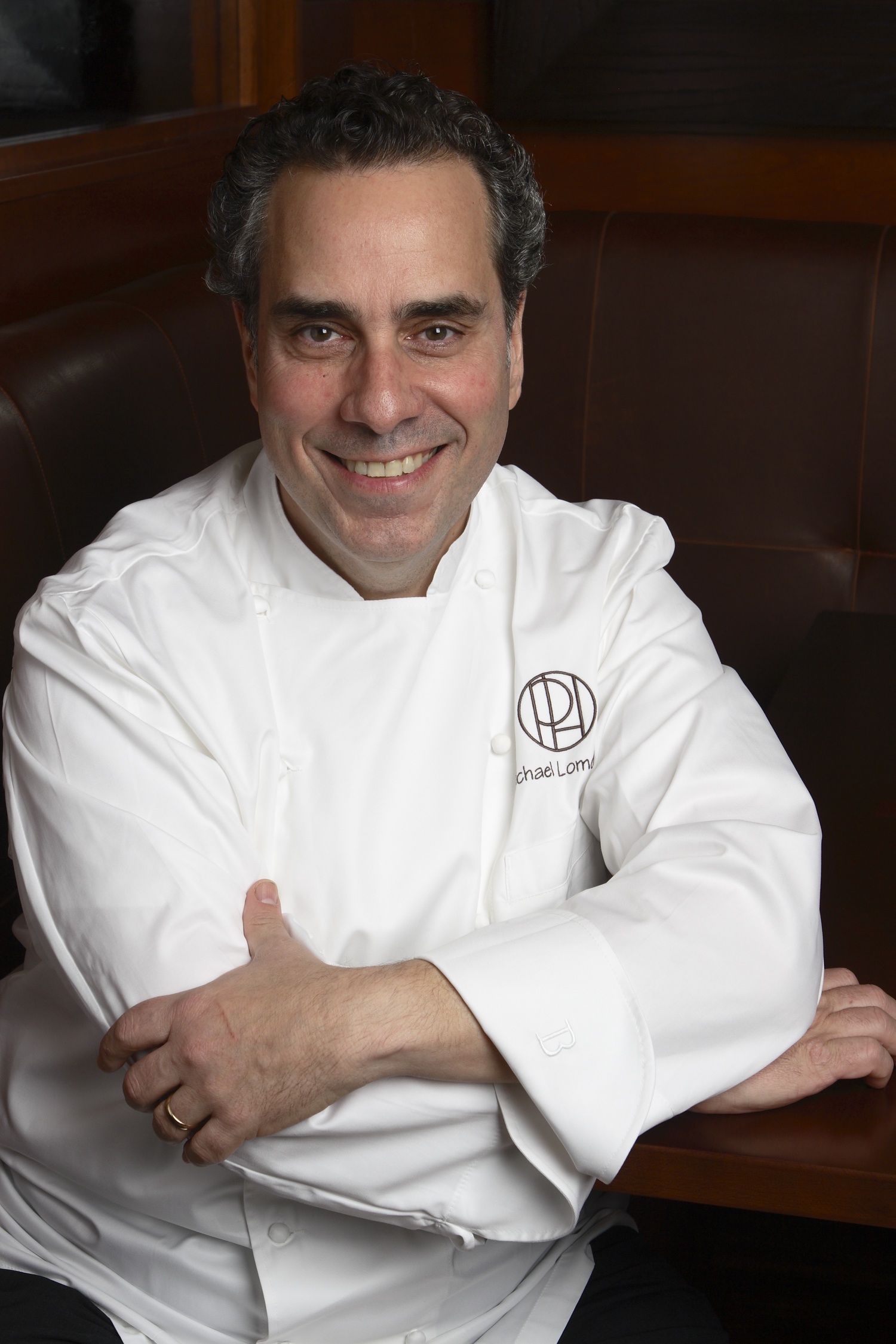 Chef-managing
partner Michael Lomonaco, manager Tim Brown, and a
fast-moving staff keep Porter House hopping without
the slightest lag in service, not least from sommelier
Roger Dagorn, who is always on hand to make the choice
of wine perfect for your taste, your dinner choices,
and your budget.
Chef-managing
partner Michael Lomonaco, manager Tim Brown, and a
fast-moving staff keep Porter House hopping without
the slightest lag in service, not least from sommelier
Roger Dagorn, who is always on hand to make the choice
of wine perfect for your taste, your dinner choices,
and your budget.
While Lomonaco (left), with chef
de cuisine Michael Ammirati, is not trying
to re-invent the wheel of a genre menu that has proven
amazingly durable, he refines every detail day to day.
Unlike steakhouses that, by never changing, have
become complacent, everything here from the bread
service to desserts are thoroughly thought through to
be the best. Who ever mentions the quality of the
bread or desserts at Luger's or Spark's? Who has ever
praised the congeniality of the service staff at Smith
& Wollensky or BLT Steak? Porter House decided
from the beginning that its guests were just that, not
numbers, not interlopers into a club where you had to
palm a maître d' to get a decent table.
Where to begin on the menu? There are several
salads, including a classic Caesar, clams Casino, and
smoked salmon. I usually go straight for either the
pan-seared sea scallops with capers, brown butter, and
celeriac or the roasted beef marrows bones with an
herb salad and toasted country bread. The jumbo lump
crabcake lives up to its billing—it is all jumbo crab
morsels, lightly bound and served with a tangy
horseradish cream. I
highly recommend the rigatoni alla bolognese, a
wonderfully rich dish correctly made without too much
tomato, and the truffled risotto with pine nuts and
black truffle butter.
A guy named Lomonaco is not going to screw
these up.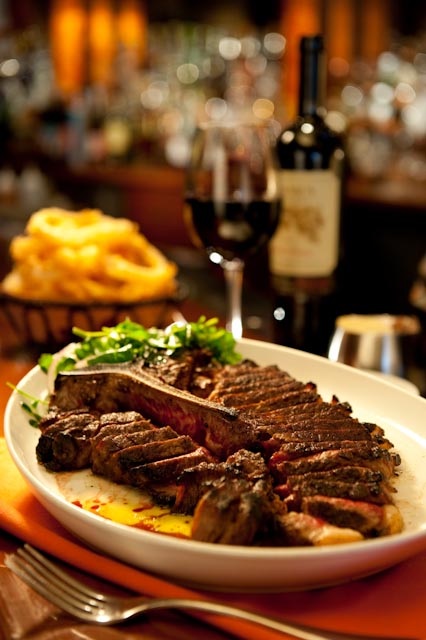
I suppose there are some who might opt for
non-meat main dishes at a place called Porter House,
though it strikes me the same as if a person went to a
dim sum restaurant and ordered General Tso’s chicken. (The
lobster offering here, oddly enough, is a pretty puny
two-pounder.) So
I can’t vouch for items like herb-roasted chicken or
grilled swordfish.
But I will go into high praise about the
massive, juicy veal chop with roasted garlic and
arugula, and the equally gargantuan Colorado lamb
t-bone chops dashed with a little rosemary. There
are four sauces to accompany these cuts, and they are
worthwhile in small dabs.
The
signature
item, porterhouse (right),
served for two but hefty enough for three or even four
is
everything I hope for in beefiness and age, surface
resilience, and crusty char. If I order it for
two, I always end up taking a good portion home. The strip
steak is excellent, as is the big cowboy ribeye, which
also comes chili rubbed, if you like. I am always
tempted to have the burger, described as “private
stock,” with Cheddar cheese, lettuce, tomato, and
onion rings. Otherwise,
as at other steakhouses, the sides—all of them first
rate, including nonpareil onion rings, crisp potato chips, and very rich
creamed spinach—are a la carte.
crisp potato chips, and very rich
creamed spinach—are a la carte.
Desserts may not be in the cards after a heavy
meal like this, but share at least one—maybe the South
Carolina coconut cake (left), all seven layers of it, or,
for winter, the pumpkin pie with sherried nutmeg
whipped cream and candied walnuts. For the kid
in you, the chocolate sundae and root beer float will
be nostalgic pleasures, even at twelve bucks a pop.
Prices have risen a bit at Porter House, but no
one is likely to leave hungry—you can easily consider
the leftovers from a main course here as tomorrow’s
lunch—and the whole experience is one of sumptuous
revelry.
As noted, some men seem to thrive on the
masochism of those old line steakhouses where the
maître d’s couldn’t care less what time you say
your rez in for and the waiters have no patience for
describing anything on the menu. Porter
House is the antithesis of that experience, a
steakhouse where the
greeting and the service are as genuine as the
quality of the beef, and every bit as generously
portioned out.
Porter
House New York is open daily for lunch and dinner,
with dinner appetizers ranging from $9-$22, and
entrees $26-$56.
NOTES FROM THE WINE CELLAR
by John Mariani
 The
idea that sweet wines go best with dessert is a no
brainer, but producers of those wines would have you
believe they go with anything and everything.
The
idea that sweet wines go best with dessert is a no
brainer, but producers of those wines would have you
believe they go with anything and everything.
A century ago that was pretty much the case,
when sweet Hungarian Tokaji, Portuguese Madeira and
Port, Spanish sherries, Italian Marsalas, and French
Sauternes were enjoyed as much with savory dishes as
with sweet. Champagnes, now preferred bone dry, were
once much sweeter, from demi-sec (half dry) to doux (sweet).
The best sweet wines
are made from grapes whose sugars have been
concentrated by drying, partial freezing, late
harvesting or infection by the so-called “Noble Rot.”
Some, like Port and Sherry, are fortified with spirits
to stabilize them. The worst are made like fruit
punch, with sugar and fruit infusions added. So in a
world where Thunderbird still outsells chardonnay and
cabernet, people still associate sweet wines with
cheap plonk and deemed them “dessert wines.”
“The term dessert wine
is a taboo today; `dry’ is where it’s at,” Daniel
Johnnes, wine director for the Dinex Group in New
York, told me by phone. “I direct my sommeliers not to
list sweet wines as `dessert wines,’ and to discuss
with the guest the varying degrees of sweetness
between, say, a Sauternes and a lighter bodied Barsac.
I think they go very well with certain braised meats
with caramelized flavors.”
But such wines are a
tough sell. Among
Sauternes, only the illustrious Cru Château
d’Yquem, sells really well, often served with foie
gras or Roquefort cheese.
“The contemporary attitude is that anything sweet is
bad for you and will put on weight, which is absolute
rubbish,” David Levin, owner of The Capital Hotel and
Restaurant in London told me. “It’s a mental block, so
we really have to promote our sweet wines. We carry
six vintages of Yquem half-bottles, which are far
easier to sell than a whole bottle.”
Levin’s
wife
Lynne, who is manages their wine estate in the Loire
Valley, has just released half bottles of Levin Noble
2010, a botrytis-affected sauvignon blanc for sale in
the UK, Australia, and Sweden. “It’s got 60 grams
residual sugar,” she says, “but the balance of acids
allows it to go well with many different dishes, like
a goat’s cheese salad.”
American sweet wine
producers are struggling too. According to Ken Young,
executive director of the Sweet and Fortified Wine
Association in Appelgate, CA, sweet wines now account
for 7.5 percent of all U.S. wine shipments. “Before
2008 we had sale increases around 6.2 percent
annually, but since then it’s only around two percent;
sales are pretty flat for fortified wines, though Late
harvest wines are doing pretty well.”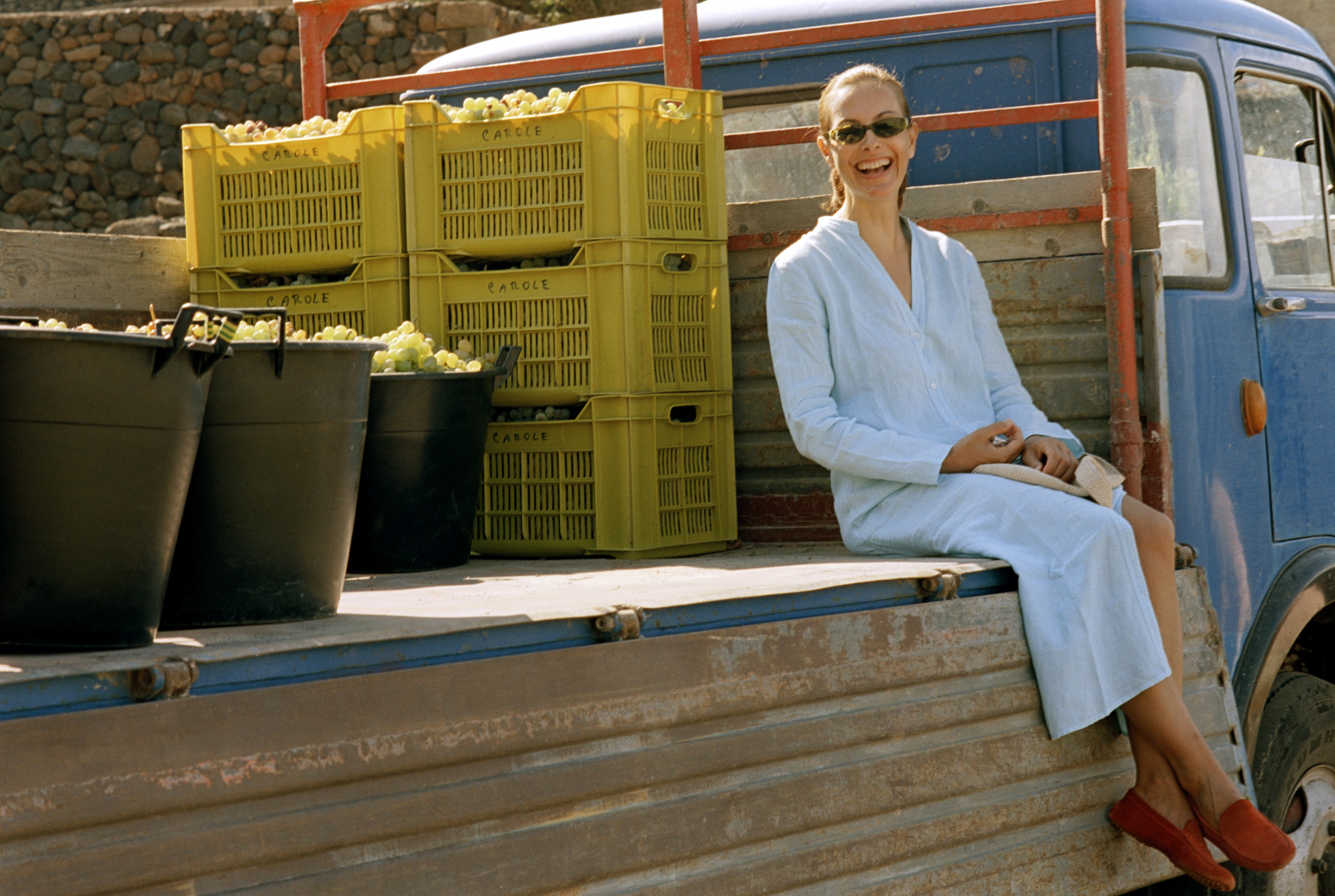
Sweet
wine
makers are, therefore, trying hard to prove their
wines go with all sorts of savory dishes. At a dinner
at Restaurant Daniel in New York, vigneron Aline Bal (above) of
Château Coutet, served her Barsacs with soft-shell crabs and pressed duck. French
actress Carole Bouquet (right), who owns a winery on the
Italian island of Pantelleria, last month served her
Sangue d’Oro passito at New York’s Boulud Sud with
first courses like octopus à la plancha with almonds,
arugula, and sherry vinegar; and sheep’s milk ricotta
with tomato confit, and tapenade.
Even the great Hungarian Tokaji wines, whose
sweetness is graded by star-like symbols called puttonyos, have
their place before and after dessert. Director of
Hungary’s Royal Tokaji Wines, Ben Hawkins, author of
the just-released Real
Men Drink Port . . . and Ladies Do Too,
told me by phone that, “the very sweet six puttonyos Tokajis
should be drunk after dessert, like a Cognac or Port.
We blend the three- and four-puttonyos wines to make an aged
late harvest wine, which has more acidity, so they can
be enjoyed with more savory dishes, like a
three-year-old Gouda, which is considered as classic a
match in Hungary as Roquefort and Sauternes is in
France.”
I, too, would insist that
sweet wines go better with cheeses than dry red wine. Whether
it’s Port with Stilton, a late harvest riesling with
goat’s cheese, or a vin santo with Parmigiano, the
flavors assimilate much better than with cabernet
sauvignon or pinot noir, which may take on a metallic
taste.
I also like sweet Chinese poultry dishes like
with sweet wines. Try a sweet rice or lychee wine with
Peking duck or General Tso’s chicken. The French
classic duck à l’orange is well served with a
Lustau Sherry, and when feasting on sweet North
African dishes like tagine and bisteeya, dry
wines just don’t work.
I’d go with a glass of ruby Port.
After dessert, curl up with a magnificent
Silvano Garcia Dulce Monastrell 2001 ($30), a powerful
argument for the individuality of Spain’s viticultural
soul and perfect with sweet-fleshed roast chestnuts
and a dish of figs before the fireplace.
And for something truly remarkable, make some
scrambled eggs in butter with shavings of black
truffles. Pour a glass of iced Pacific Rim Vin de
Glaciere Riesling 2010 ($16 half bottle), made in
Washington’s Yakima Valley. Now, that is a decadent
revelation indeed.
John Mariani's wine column appears in Bloomberg Muse News, from which this story was adapted. Bloomberg News covers Culture from art, books, and theater to wine, travel, and food on a daily basis.
❖❖❖
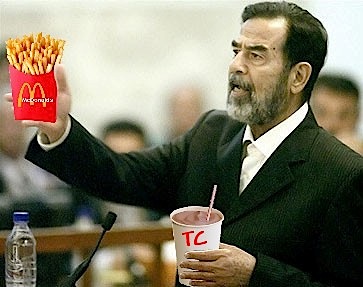
BAD TASTE IN THE MOUTH NUMBER 556
According to the NY Daily News, gold-rimmed china plates from Saddam Hussein's many dining rooms have ended up at Park Avenue Autumn restaurant as part of a participatory art installation. To enhance the "complicated" experience, Chef Kevin Lasko created an Iraqi-inspired dish of venison chop covered in tahini and date syrup, with pomegranates, pine nuts, and scallions. Lasko compares the tahini to Saddam Hussein himself: “It's very good to eat and it tastes good, but, at the same time, there are bitter memories because of Saddam. It's actually kind of very similar to how the tahini and the date syrup are — the tahini is very bitter and the syrup is very sweet.”
THE POLICE BARRICADES?

"Since
moving
from New York to the Bay Area, I've looked back on
winter with the sweet sorrow of a complicated
relationship. Sure, it often hurt, but the pain
was interspersed with threads of warmth and
relief. In this land without well-defined seasons
(don't kid yourselves), I miss sharp contrasts.
Thus when Oakland's balmy October weather
developed an abrupt chill, I headed to Kitchen
388. I may have missed this year's Halloween
snowstorm in the Northeast, but at least I could
throw on a sweater and duck into a warm nook for
breakfast."--Jesse Hirsch, "Hot and Cold at Kitchen
388," SF Weekly.
❖❖❖
Any of John Mariani's
books below may be ordered from amazon.com.
 |
My latest book, written with Jim Heimann and Steven Heller, Menu Design in America, 1850-1985 (Taschen Books), has just appeared, with nearly 1,000 beautiful, historic, hilarious, sometimes shocking menus dating back to before the Civil War and going through the Gilded Age, the Jazz Age, the Depression, the nightclub era of the 1930s and 1940s, the Space Age era, and the age when menus were a form of advertising in innovative explosions of color and modern design. The book is a chronicle of changing tastes and mores and says as much about America as about its food and drink.
“Luxuriating vicariously in the pleasures of this book. . . you can’t help but become hungry. . .for the food of course, but also for something more: the bygone days of our country’s splendidly rich and complex past. Epicureans of both good food and artful design will do well to make it their cofee table’s main course.”—Chip Kidd, Wall Street Journal.
“[The menus] reflect the amazing craftsmanship that many restaurants applied to their bills of fare, and suggest that today’s restaurateurs could learn a lot from their predecessors.”—Rebecca Marx, The Village Voice. |
"Eating Italian will never be the same after reading John Mariani's entertaining and savory gastronomical history of the cuisine of Italy and how it won over appetites worldwide. . . . This book is such a tasteful narrative that it will literally make you hungry for Italian food and arouse your appetite for gastronomical history."--Don Oldenburg, USA Today. "Italian
restaurants--some good, some glitzy--far
outnumber their French rivals. Many of
these establishments are zestfully described
in How Italian Food Conquered the World, an
entertaining and fact-filled chronicle by
food-and-wine correspondent John F.
Mariani."--Aram Bakshian Jr., Wall Street
Journal.
"Equal parts
history, sociology, gastronomy, and just
plain fun, How Italian Food Conquered the
World tells the captivating and delicious
story of the (let's face it) everybody's
favorite cuisine with clarity, verve and
more than one surprise."--Colman Andrews,
editorial director of The Daily
Meal.com. "A fantastic and fascinating
read, covering everything from the influence
of Venice's spice trade to the impact of
Italian immigrants in America and the
evolution of alta cucina. This book will
serve as a terrific resource to anyone
interested in the real story of Italian
food."--Mary Ann Esposito, host of PBS-TV's
Ciao
Italia. "John Mariani has written the
definitive history of how Italians won their
way into our hearts, minds, and
stomachs. It's a story of pleasure over
pomp and taste over technique."--Danny Meyer,
owner of NYC restaurants Union Square Cafe,
Gotham Bar & Grill, The Modern, and
Maialino.
|
 |
 |
 |
 |
 |
 |
 |
 |
 Everett Potter's Travel Report:
Everett Potter's Travel Report: 
 Eating Las Vegas
is the new on-line site for Virtual Gourmet
contributor John A. Curtas., who since 1995
has been commenting on the Las Vegas food
scene and reviewing restaurants for Nevada
Public Radio. He is also the
restaurant critic for KLAS TV, Channel 8 in
Las Vegas, and his past reviews can be
accessed at KNPR.org.
Click on the logo below to go directly to
his site.
Eating Las Vegas
is the new on-line site for Virtual Gourmet
contributor John A. Curtas., who since 1995
has been commenting on the Las Vegas food
scene and reviewing restaurants for Nevada
Public Radio. He is also the
restaurant critic for KLAS TV, Channel 8 in
Las Vegas, and his past reviews can be
accessed at KNPR.org.
Click on the logo below to go directly to
his site.

Tennis Resorts Online: A Critical Guide to the World's Best Tennis Resorts and Tennis Camps, published by ROGER COX, who has spent more than two decades writing about tennis travel, including a 17-year stretch for Tennis magazine. He has also written for Arthur Frommer's Budget Travel, New York Magazine, Travel & Leisure, Esquire, Money, USTA Magazine, Men's Journal, and The Robb Report. He has authored two books-The World's Best Tennis Vacations (Stephen Greene Press/Viking Penguin, 1990) and The Best Places to Stay in the Rockies (Houghton Mifflin, 1992 & 1994), and the Melbourne (Australia) chapter to the Wall Street Journal Business Guide to Cities of the Pacific Rim (Fodor's Travel Guides, 1991).


The Family Travel Forum - A
community for those who "Have Kids, Still Travel" and
want to make family vacations more fun, less work and
better value. FTF's travel and parenting features,
including reviews of tropical and ski resorts, reunion
destinations, attractions, holiday weekends, family
festivals, cruises, and all kinds of vacation ideas
should be the first port of call for family vacation
planners. http://www.familytravelforum.com/index.html
ALL YOU NEED BEFORE YOU GO


MARIANI'S VIRTUAL GOURMET
NEWSLETTER is published weekly. Editor/Publisher: John
Mariani.
Contributing Writers: Christopher Mariani, Robert Mariani,
John A. Curtas, Edward Brivio, Mort Hochstein,
Suzanne Wright, and Brian Freedman. Contributing
Photographers: Galina Stepanoff-Dargery,
Bobby Pirillo. Technical Advisor: Gerry McLoughlin.
© copyright John Mariani 2011
